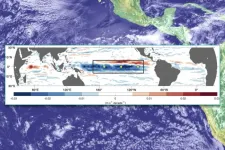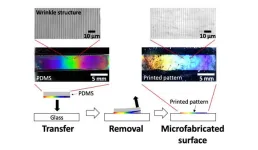(Press-News.org) The visible universe — all the potatoes, gas giants, steamy romance novels, black holes, questionable tattoos, and overwritten sentences — accounts for only 5 percent of the cosmos.
A Virginia Tech-led team is hunting for the rest of it, not with telescopes or particle colliders, but by scrutinizing billion-year-old rocks for traces of dark matter.
In leading a transdisciplinary team from multiple universities on this unconventional search, physics’ Patrick Huber is also taking an unconventional step: from theoretical work into experimental work.
With support from a $3.5 million Growing Convergence Research award from the National Science Foundation and a separate $750,000 award from the National Nuclear Security Administration, Huber is building a new lab in Robeson Hall to test dark matter theories — and see what else might come to light along the way.
Dark matter is super dark
Scientists can only infer dark matter’s existence because objects in the universe fall faster than they should around the center of galaxies. Gravity from this unseen substance accounts for the extra oomph.
Unlike the bump and grind of regular stuff, dark matter is thought to interact only very weakly with other matter, imperceptible except when one happens to bump into a nucleus of a visible matter atom. Recoiling from the collision like an atomic billiard ball, the nucleus deposits a spark of energy.
Over the past 50 years, physicists have conducted all manner of dark-matter experiments in hopes of witnessing one of these rare recoil events.
So far? Dark matter has stayed dark. Physicists haven’t turned up any hard evidence for dark matter. Now they’re turning down — deep down.
Paleodetectives
If dark matter exists, there’s a chance it has interacted with the Earth at some point in its 4.6 billion-year-old history. What if, instead of waiting for dark matter to come to them, scientists could excavate ancient evidence from minerals deep in the Earth?
While the idea for using rocks as subterranean detectors was first proposed in the 1980s, technological advances prompted researchers, including Huber, to revisit this idea.
“It’s crazy. When I first heard about this idea, I was like — this is insane. I want to do it,” said Huber, the William E. Hassinger, Jr. Senior Faculty Fellow.
Huber, being a theoretical physicist, came up with a theory of how to solve it. But the theory wasn’t enough. If this plan was possible, he wanted to see what it would take to execute it.
“Other people in their midlife crisis might take a mistress or get a sports car. I got a lab,” Huber said.
Who knocked the nuclei?
By developing and using sophisticated imaging techniques, Huber and his collaborators hope to uncover miniature trails of destruction left by long-ago dark matter interactions inside crystal lattice structures.
When a high-energy particle bounces off a nucleus inside a rock, the explosive recoil can pop a nucleus out of place, said Vsevolod Ivanov, a researcher at the Virginia Tech National Security Institute who is collaborating with Huber. The ejected nucleus and the empty gap it leaves behind represent structural changes within crystal.
“We’ll take a crystal that’s been exposed to different particles for millions of years and subtract the distributions that correspond to things we do know,” Ivanov said. “Whatever is left must be something new, and that could be the dark matter.”
Most dark matter experiments are conducted underground to cut back on interference from other high-energy particles called cosmic rays, but going underground presents a new set of problems. The planet pulses with a radioactive background that can also jostle nuclei. University Distinguished Professor Robert Bodnar, recently inducted into the National Academy of Sciences, will be working with Huber’s team to identify, locate, and characterize minerals that could serve as suitable detectors.
Proof in 3D
To start in on this massive imaging task, Huber is working with researchers at the University of Zurich’s Brain Research Institute who provided access to special microbiology imaging technology typically used to image animal nervous systems.
The team has already started generating 3D renderings of high-energy particle tracks in synthetic lithium fluoride. This artificial crystal won’t make a good dark-matter detector, said Huber, but it will help establish the full range of signals while keeping the crystal intact. In an unexpected twist, applications of lithium fluoride imaging technology include “nuclear transparency devices,” which might look like backpack-sized monitoring devices for nuclear reactors.
With tangential outputs from this “insane” research objective already proving of immediate value, Huber his collaborators will dig deeper and look closer to see if an old rock can tell us how the stars fly around the galaxy.
END
Ancient rocks may bring dark matter to light
With new imaging capabilities, the first successful dark-matter detector might be some old rock
2024-10-31
ELSE PRESS RELEASES FROM THIS DATE:
Study reveals acceleration in Pacific upper-ocean circulation over past 30 years, impacting global weather patterns
2024-10-31
A new study published October 31, 2024, in the Journal of Geophysical Research: Oceans has revealed significant acceleration in the upper-ocean circulation of the equatorial Pacific over the past 30 years. This acceleration is primarily driven by intensified atmospheric winds, leading to increased oceanic currents that are both stronger and shallower, with potential impacts on regional and global climate patterns, including the frequency and intensity of El Niño and La Niña events. The study provides a spatial view of these long-term trends from observations, adding at least ...
Virginia Tech researcher finds AI could help improve city planning
2024-10-31
Traditional city planning methods require significant technical expertise and manual work.
A Virginia Tech researcher is working to change that.
New research shows the potential of large language models (LLMs), such as ChatGPT and Google’s Gemini, for assessing the human-made environment using street-view images.
By comparing LLM performance with traditional city planning deep learning methods, the study from the College of Natural Resources and Environment found that LLM-based performance is similar with established approaches. Unlike ...
A trick of light: UC Irvine researchers turn silicon into direct bandgap semiconductor
2024-10-31
Irvine, Calif., Oct. 31, 2024 — By creating a new way for light and matter to interact, researchers at the University of California, Irvine have enabled the manufacturing of ultrathin silicon solar cells that could help spread the energy-converting technology to a vast range of applications, including thermoelectric clothing and onboard vehicle and device charging.
The development, subject of a paper recently published as the cover story in the journal ACS Nano, hinges on the UC Irvine researchers’ conversion of pure silicon from an indirect to a direct bandgap semiconductor through the way it interacts ...
NIH trial of rectal microbicide for HIV prevention begins in the United States
2024-10-31
WHAT:
A clinical trial sponsored by the National Institutes of Health (NIH) has launched to examine the safety and acceptability of a novel rectal HIV microbicide douche containing the antiretroviral drug tenofovir. This “on-demand” HIV prevention approach involves using the microbicide prior to a potential exposure from receptive anal intercourse.
Several forms of HIV pre-exposure prophylaxis (PrEP) are in use in the United States and globally, namely daily oral pills, long-acting injections, and a monthly vaginal ring. The Centers for Disease Control and Prevention advises that gay, bisexual and other men who have sex with ...
Development of a simple, revolutionary printing technique for periodic nano/microstructures
2024-10-31
1. A team of researchers from NIMS and the University of Connecticut has developed a printing technique capable of forming a periodic nano/microstructure on the surface of a polydimethylsiloxane (PDMS) slab and easily transferring it onto the surface of a glass substrate. This technique enables us to create materials with useful functions—including water-repellency and the ability to generate structural colors—without expensive equipment and complex processes. In addition, the technique may be used to fabricate materials capable of realizing anti-fogging and/or generating structural colors on their surfaces—functions potentially useful in the development ...
Drug supply chain issues more likely to result in shortages in US than Canada
2024-10-31
Reports of drug-related supply-chain issues were 40% less likely to result in drug shortages in Canada versus the United States, according to a new study from University of Pittsburgh researchers and published today in JAMA.
The analysis looked at drugs that had reports of supply-chain disruptions between 2017 and 2021 in both countries and found that within 12 months of an initial U.S. report, nearly half resulted in drug shortages in the U.S. versus about one-third in Canada. There was also a consistently lower ...
Differences in Drug Shortages in the US and Canada
2024-10-31
About The Study: Drug-related reports of supply chain issues were 40% less likely to result in meaningful drug shortages in Canada compared with the U.S. These findings highlight the need for international cooperation between countries to curb the effects of drug shortages and improve resiliency of the supply chain for drugs.
Quote from corresponding author Katie J. Suda, PharmD, MS:
“Our U.S. drug supply chain is linked globally – shortages in one country can happen in another country – presenting an opportunity to compare and ...
Survival outcomes of an early intervention smoking cessation treatment after a cancer diagnosis
2024-10-31
About The Study: The results of this prospective cohort study suggest that evidence-based smoking cessation treatment within 6 months following a cancer diagnosis maximizes survival benefit. This study supports smoking cessation as an important early clinical intervention for patients after being diagnosed with cancer.
Corresponding Author: To contact the corresponding author, Paul M. Cinciripini, PhD, email pcinciri@mdanderson.org.
To access the embargoed study: Visit our For The Media website at this link ...
Quitting smoking after cancer diagnosis improves survival across a wide variety of cancers
2024-10-31
HOUSTON ― Smokers who are diagnosed with cancer now have more incentive to quit, as researchers from The University of Texas MD Anderson Cancer Center have found survival outcomes were optimized when patients quit smoking within six months of their diagnosis.
Study results, published today in JAMA Oncology, found a 22%-26% reduction in cancer-related mortality among those who had quit smoking within three months after tobacco treatment began. The best outcomes were observed in patients who started tobacco treatment within six months of a cancer diagnosis and were abstinent from smoking three months later. Survival for these patients increased from 2.1 years for ...
Genomic databases need more diversity
2024-10-31
CONTACT: Heide Aungst
HAungst@som.umaryland.edu
(216) 970-5773 (cell)
UNDER EMBARGO UNTIL 11 am on OCT. 31
Genomic Databases Need More Diversity
University of Maryland School of Medicine Researchers Create Large Database of Latin American Populations to Tackle Health Disparities
BALTIMORE, Oct. 31, 2024: It is commonly known that most genomic databases are biased toward people with European ancestry. Scientists have warned that leaving out other populations could skew results in areas such as drug development, ...
LAST 30 PRESS RELEASES:
Scientists discover first method to safely back up quantum information
A role for orange pigments in birds and human redheads
Pathways to net-zero greenhouse gas emissions for Southeast Asia
A JBNU–KIMS collaborative study on a cost-effective alloy matches superalloys for power plants and energy infrastructure
New study overturns long-held model of how plants coordinate immune responses.
New AI model predicts disease risk while you sleep
Scientists discover molecular ‘reshuffle’ and crack an 80-year-old conundrum
How stressors during pregnancy impact the developing fetal brain
Electrons lag behind the nucleus
From fungi to brain cells: one scientist's winding path reveals how epigenomics shapes neural destiny
Schizophrenia and osteoporosis share 195 genetic loci, highlighting unexpected biological bridges between brain and bone
Schizophrenia-linked genetic variant renders key brain receptor completely unresponsive to both natural and therapeutic compounds
Innovative review reveals overlooked complexity in cellular energy sensor's dual roles in Alzheimer's disease
Autism research reframed: Why heterogeneity is the data, not the noise
Brazil's genetic treasure trove: supercentenarians reveal secrets of extreme human longevity
The (metabolic) cost of life
CFRI special issue call for papers: New Frontiers in Sustainable Finance
HKU Engineering scholar demonstrates the smallest all-printed infrared photodetectors to date
Precision empowerment for brain "eavesdropping": CAS team develops triple-electrode integrated functional electrode for simultaneous monitoring of neural signals and chemical transmitters during sleep
Single-capillary endothelial dysfunction resolved by optoacoustic mesoscopy
HKU three research projects named among ‘Top 10 Innovation & Technology News in Hong Kong 2025’ showcasing excellence in research and technology transfer
NLRSeek: A reannotation-based pipeline for mining missing NLR genes in sequenced genomes
A strand and whole genome duplication–aware collinear gene identification tool
Light storage in light cages: A revolutionary approach to on-chip quantum memories
Point spread function decoupling in computational fluorescence microscopy
BacPhase: Long-insert paired-end sequencing for bin marker construction and genome phasing
GmWOX1 regulates the mediolateral polarity of compound leaves in soybean
ChargeFabrica: An open-source simulation tool that aims to accelerate search for high performance perovskite solar cells
High levels of ADAR overexpression induce abundant and stochastic off-target RNA editing in rice protoplasts
On-demand upgraded recycling of polyethylene and construction of sustainable multifunctional materials based on the "LEGO" strategy
[Press-News.org] Ancient rocks may bring dark matter to lightWith new imaging capabilities, the first successful dark-matter detector might be some old rock






